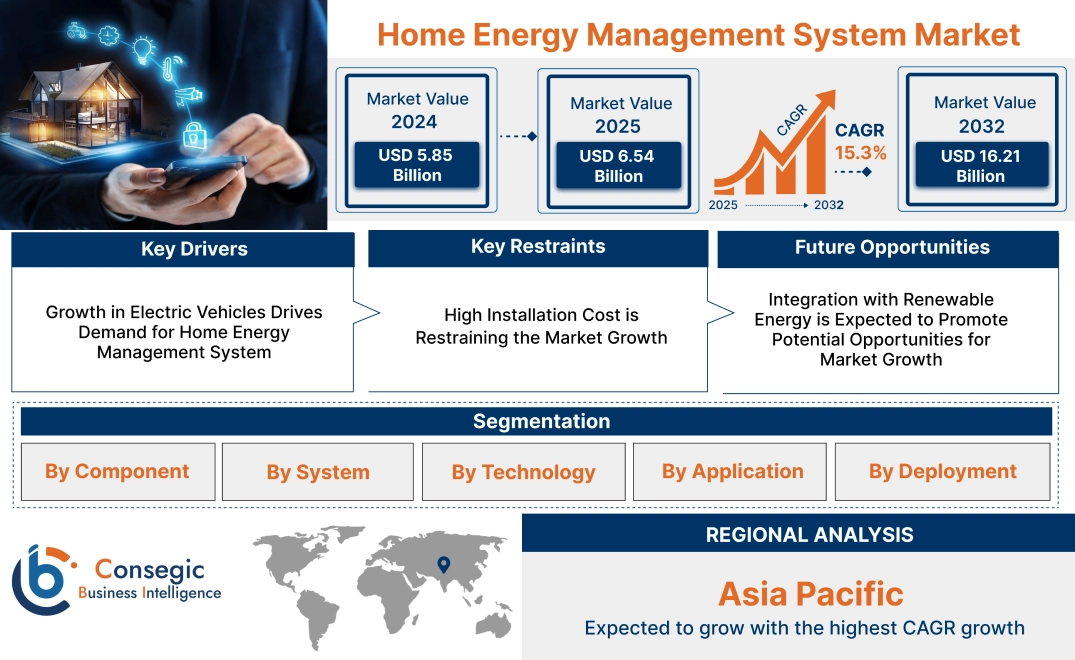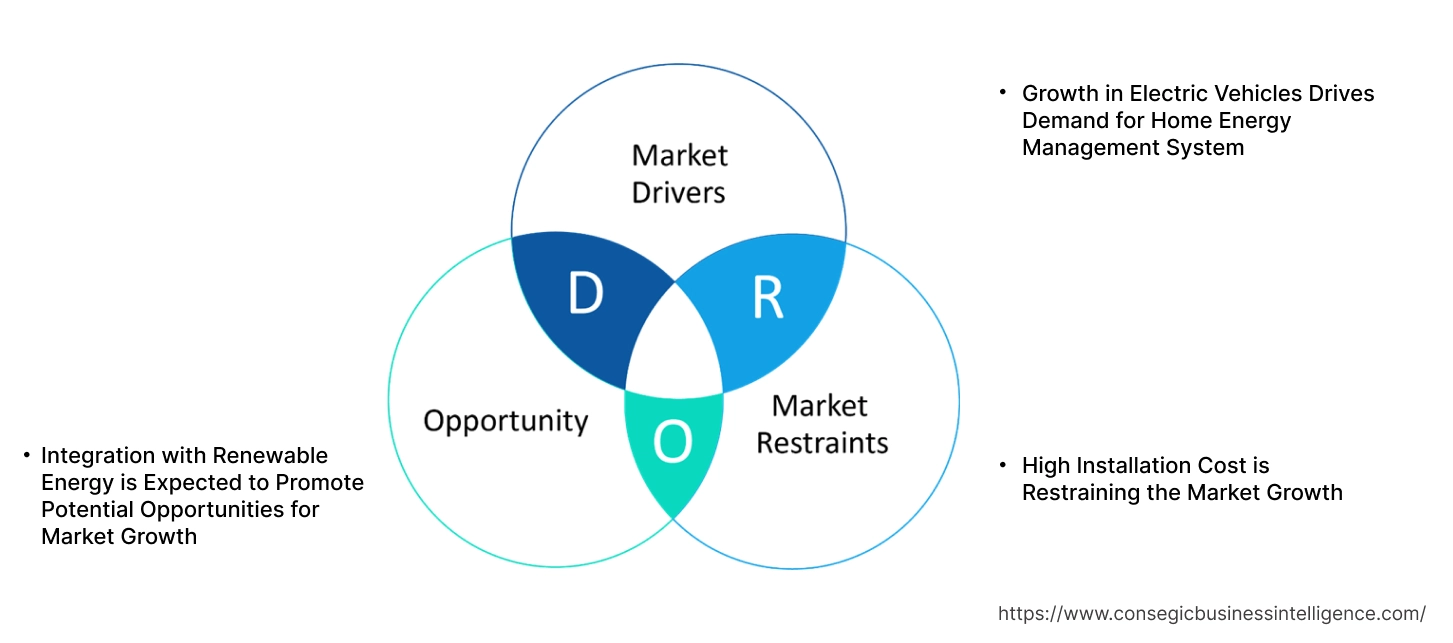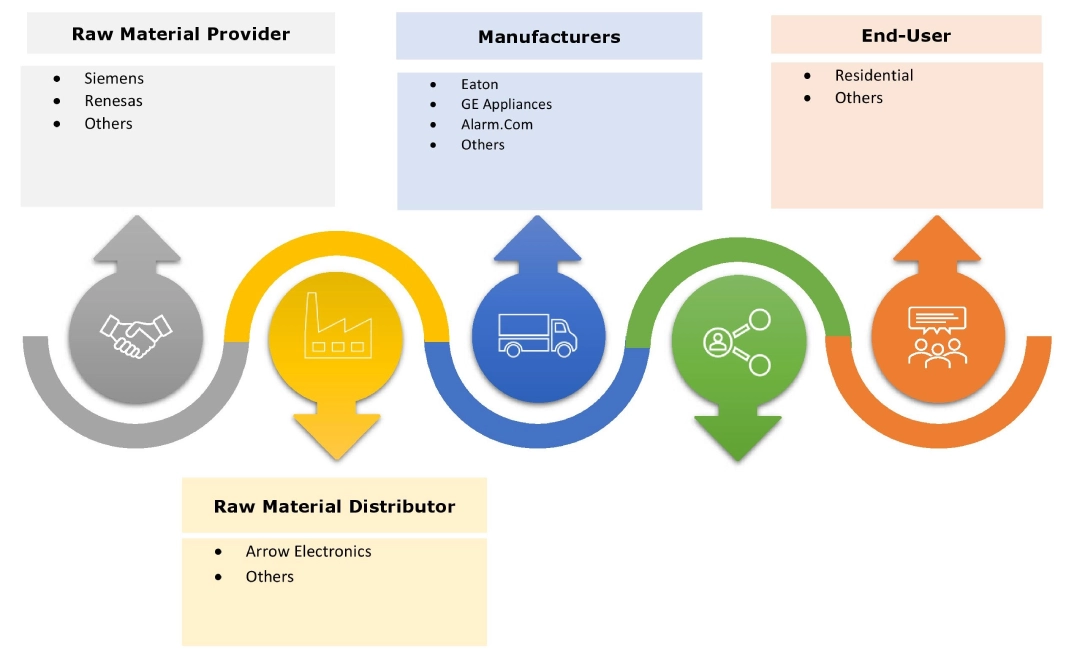- Summary
- Table Of Content
- Methodology
Home Energy Management System Market Size:
Home Energy Management System Market size is estimated to reach over USD 16.21 Billion by 2032 from a value of USD 5.85 Billion in 2024 and is projected to grow by USD 6.54 Billion in 2025, growing at a CAGR of 15.3% from 2025 to 2032.
Home Energy Management System Market Scope & Overview:
Home energy management system is a combination of hardware and software that optimally distributes energy flows between a wide ranges of appliances such as refrigerators, EV charging stations and others at home. Additionally, the system plays a crucial role in saving energy by making wise consumption decisions which in turn dives the home energy management system market growth. Moreover, the advantages of utilizing the system include increased energy efficiency, enhanced environmental sustainability, reduced carbon footprint, increased renewable energy adoption, and others. Further, the rapidly changing energy landscape is influencing the cost and tariffs of electricity, which in turn is boosting the home energy management system market demand.
Key Drivers:
Growth in Electric Vehicles Drives Demand for Home Energy Management System
The rising adoption of electric vehicles is propelling the integration of EV charging systems with energy management system which in turn allows smart, efficient, and cost-effective energy usage is driving the home energy management system market growth. Additionally, the EV charging system consumes huge amounts of energy, increasing the electricity cost for users and energy management system helps manage the energy consumption is boosting the home energy management system market demand.
- For instance, in January 2024, Black Box Innovations launched patented energy management device for applications in residential homes. The device provides cost-effective, high-speed EV charger system for electric vehicles.
Therefore, the rising adoption of electric vehicles is driving the adoption of systems, in turn proliferating the growth of the market.
Key Restraints:
High Installation Cost is Restraining the Market Growth
The energy management system includes hardware such as sensors, smart meters and others as well as software for installation incurs huge initial investment in turn hindering the home energy management system market expansion. Further, the high initial investment deters homeowners from adopting energy management system at homes, even after providing potential long-term benefits.
Therefore, the high costs of installation are restraining the home energy management system market expansion.
Future Opportunities :
Integration with Renewable Energy is Expected to Promote Potential Opportunities for Market Growth
The rising adoption of renewable energy sources such as solar and wind is helping homeowners to reduce energy consumption by optimizing electricity with energy management system is boosting the home energy management system market opportunities. Additionally, the advantages of integrating renewable energy include reduced energy cost, reduced carbon footprint, increased energy efficiency, and others. Further, the increasing focus towards sustainability is driving the adoption of system in turn boosting the market progress.
- For instance, in September 2024, Eaton launched AbleEdge system which is a home energy management system for homeowners. The system is designed for interoperability with solar system and residential energy storage in turn minimizing equipment and maximizing functionality.
Hence, the integration of renewable energy with energy management system is anticipated to increase utilization, in turn promoting prospect for home energy management system market opportunities during the forecast period.
Home Energy Management System Market Segmental Analysis :
By Component:
Based on the component, the market is segmented into hardware, software, and services.
Trends in the Component:
- The integration of AI and IoT with the hardware components, enable real-time monitoring, predictive analytics, and automated energy consumption which in turn drives the home energy management system market trend.
- The rising adoption of smart home climate control software to optimize energy management and environmental conditions is driving the software segment progress.
Hardware accounted for the largest revenue share of 58.26% in the year 2024.
- The hardware segment comprises of control devices, communication or display devices and others.
- Additionally, the primary function of hardware component in the system is to monitor, control, optimize consumption and shift energy consumption during peak hours.
- Further, the key factors driving the adoption of system include reduced energy cost, increased energy efficiency, enhanced comfort and others in turn drives the home energy management system market size.
- For instance, in February 2025, Kenmore launched advanced home energy management system comprising of smart plugs, leak sensors, and a smart home manager app for seamless integration to offer energy-efficient living.
- Thus, as per the market analysis, aforementioned key factor is driving the hardware segment.
Software is anticipated to register the fastest CAGR during the forecast period.
- The software allows homeowners to track and manage energy consumption, which in turn helps in achieving the goal of reducing costs and environmental impact.
- Additionally, the primary function of software is to collect data, analyze data, control and automation among others is driving the home energy management system market share.
- Further, the rising demand for digital transformation of buildings is driving the adoption of software which in turn boosts the home energy management system market size.
- Therefore, according to the home energy management system market analysis, the rising demand for digital transformation of buildings are anticipated to boost the market during the forecast period.
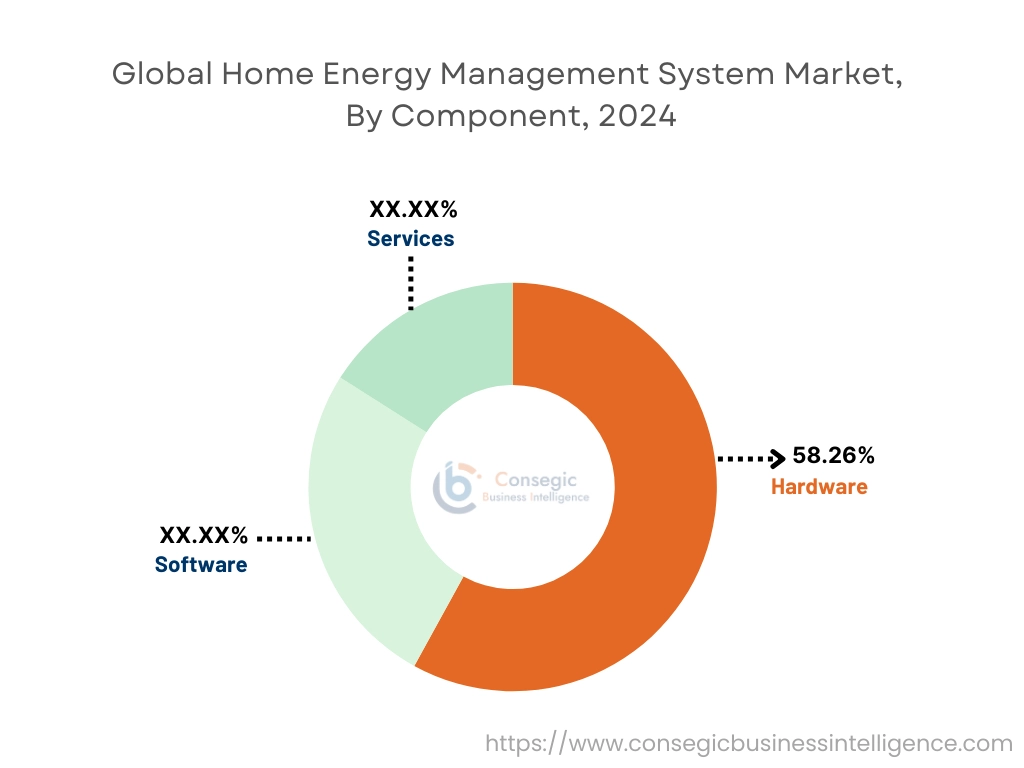
By System:
Based on the system, the market is segmented into lighting controls, thermostats, self-monitoring systems, advanced central controllers, and intelligent HVAC controllers.
Trends in the System:
- The need for remote controlled lighting system is diving the adoption of advanced lighting controls which in turn is fueling the home energy management system market trend.
- The trend towards automating home is driving the adoption of advanced central controllers for controlling various smart home devices.
Intelligent HVAC Controllers accounted for the largest revenue share in the year 2024.
- The intelligent HVAC controller integrates with energy management system to monitor and controls energy generation, heating, ventilation, and air conditioning systems within a household.
- Additionally, the advantages include reduced energy consumption, lowered energy bills, improved comfort and others.
- Further, intelligent HVAC controller provides remote monitoring and control capabilities which is controlled through smartphone app or web portal in turn driving the adoption of intelligent HVAC controllers.
- Thus, according to the home energy management system market analysis, the remote monitoring and control feature is driving the adoption of intelligent HVAC controllers.
Thermostats is anticipated to register the fastest CAGR during the forecast period.
- The thermostats seamlessly integrate with energy management systems to optimize energy consumption and efficiency.
- Further, smart thermostats have the ability to learn user habits and adjusting temperature settings accordingly is driving the adoption of thermostats in turn is driving the home energy management system market share.
- For instance, in October 2024, Building36 launched smart thermostat offering easy and convenient connection for homeowners. The device is embedded with cellular hub which eliminates issues such as weak Wi-Fi signals or forgotten passwords.
- Therefore, as per the market analysis, the need to optimize energy consumption and efficiency are anticipated to boost the market during the forecast period.
By Technology:
Based on the technology, the market is segmented into wireless, wired, and hybrid.
Trends in the Technology:
- Advancements in IoT, AI, and cloud-based platforms utilized for energy management system is driving the adoption of wireless technology.
- The emergence of Wi-Fi 6 enabling faster connectivity for real-time energy tracking is driving the wireless segment progress.
Wireless accounted for the largest revenue share in the year 2024 and is anticipated to register the fastest CAGR during the forecast period.
- The wireless segment comprises of Wi-Fi, ZigBee, Z-Wave, Bluetooth, and Others. Also, Wi-Fi is widely utilized due to availability, compatibility, and ability to facilitate seamless connectivity.
- Additionally, the wireless connection enables remote monitoring and control of energy usage, providing homeowners convenience and insights about the operation of energy management systems.
- Further, the increasing number of smart homes is driving the need for seamless integration with others smart home devices in turn boosting the wireless segment progress.
- Thus, as per the market analysis, increasing number of smart homes as well as enabling remote monitoring and control is driving the adoption of wireless technology.
By Application:
Based on the application, the market is bifurcated into new construction and retrofit.
Trends in the Application:
- The trend towards achieving sustainability goals and stringent government rules is driving the retrofit segment.
- The integration of EV charging system with the energy management system is driving the market adoption in new construction.
Retrofit accounted for the largest revenue share in the year 2024.
- The retrofitting reduces the operational costs, which in turn helps to attract tenants and gain a market edge.
- Additionally, the advantages of retrofitting include reduced energy costs, increased comfort, reduced carbon footprint, enhanced home value and others.
- Further, the rising energy cost is propelling homeowners to upgrade existing homes with new technologies and monitoring energy consumption.
- Thus, as per the market analysis, the rising energy cost is driving the retrofit segment.
New Construction is anticipated to register the fastest CAGR during the forecast period.
- The new construction integrates smart energy solutions to enhance the property value which in turn drives the home energy management system industry.
- Further, the changing rules and regulations as well as government promoting energy efficient systems is driving the adoption of energy management system into new construction.
- For instance, in October 2024, Schneider Electric launched Schneider home designed to simplify energy management for homeowners which combines solar, battery, EV charging, and utility power among others into a system controlled by app.
- Therefore, as per the market analysis, the rules and regulations as well as government promoting energy efficient systems are anticipated to boost the market during the forecast period.
By Deployment:
Based on the deployment, the market is bifurcated into on-premises and cloud.
Trends in the Deployment:
- The trend towards automation is driving the adoption of cloud deployment in energy management systems.
- The growing environmental awareness is driving the adoption of on-premise deployment of energy management systems.
On-Premise accounted for the largest revenue share in the year 2024.
- The on-premise deployments of energy management system is managed within the home and does not rely on cloud-based solution. The deployment offers faster data access as compared to cloud deployment.
- Further, the increasing adoption of smart home technologies which offer flexibility and control is driving the on-premise deployment segment.
- For instance, in June 2024, Aurora Solar launched whole home energy management solution as well as integrate easily with solar-plus-storage system.
- Thus, as per the market analysis, increasing adoption of smart home technologies is driving the on-premise deployment.
Cloud is anticipated to register the fastest CAGR during the forecast period.
- The advancement in cellular connectivity as well as emergence of Wi-Fi 6 is propelling the adoption of cloud deployment due to faster remote access and control over the devices.
- Also, the primary function of cloud deployment is to collect data, analyze data, monitor and control energy consumption among others.
- Further, the increasing adoption of cloud computing to remotely monitor, analyze, and optimize energy usage is driving the cloud deployment segment.
- Therefore, the increasing adoption of cloud computing are anticipated to boost the market during the forecast period.
Regional Analysis:
The regions covered are North America, Europe, Asia Pacific, Middle East and Africa, and Latin America.
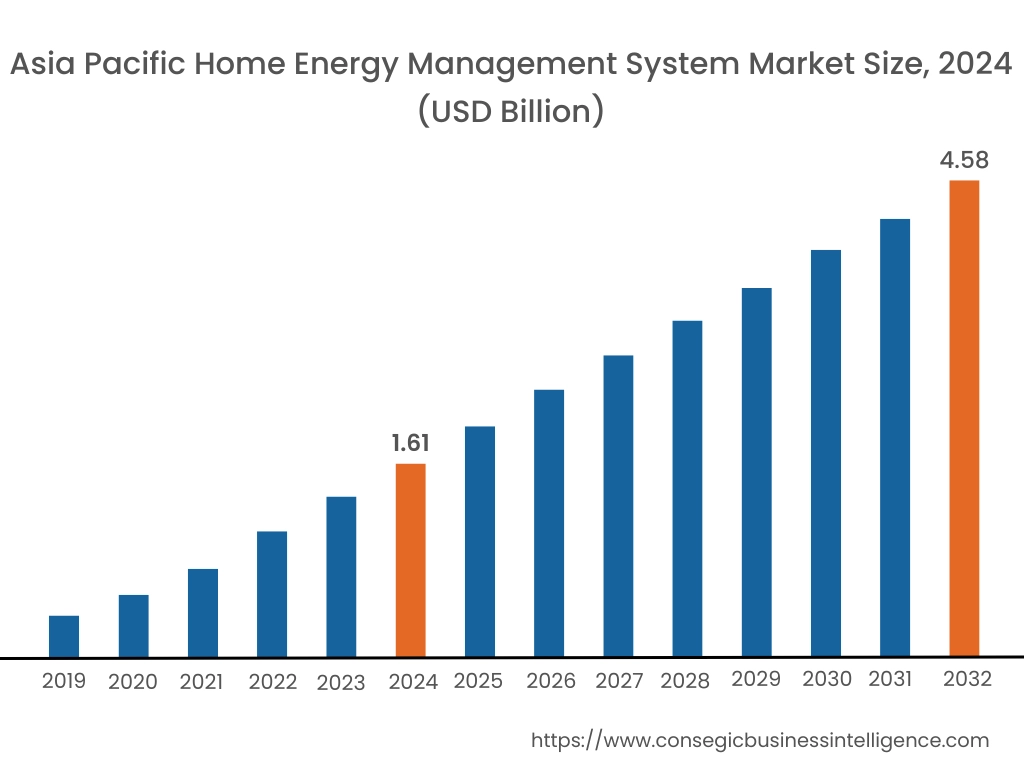
Asia Pacific region was valued at USD 1.61 Billion in 2024. Moreover, it is projected to grow by USD 1.80 Billion in 2025 and reach over USD 4.58 Billion by 2032. Out of this, China accounted for the maximum revenue share of 29.63%. The market is mainly driven by growing smart grid technology industry as well as government support and subsidies. Furthermore, factors including rapid urbanization and rising electricity demand are projected to drive the market growth in Asia Pacific region during the forecast period.
- For instance, according to PIB, the Indian Per capita electricity consumption have reached 1,395 kWh in 2023-24, which is a rise of 45.8% compared to 957 kWh in 2013-14 which in turn is paving the way for adoption of energy management system.
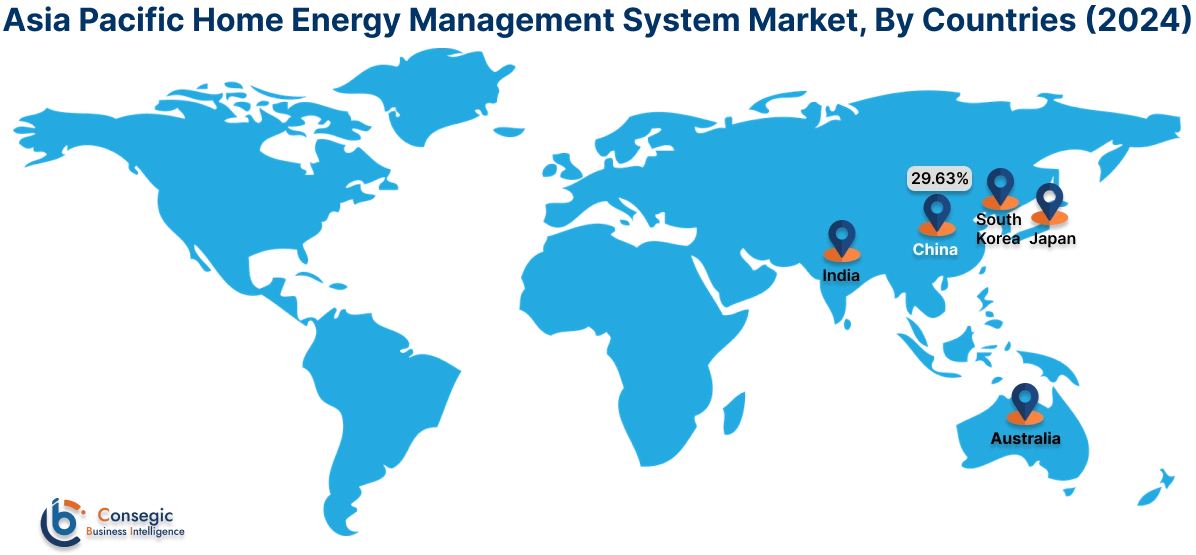
North America is estimated to reach over USD 5.88 Billion by 2032 from a value of USD 2.13 Billion in 2024 and is projected to grow by USD 2.38 Billion in 2025. The North American region's growing smart home adoption offers lucrative growth prospects for the market. Additionally, grid modernization and rising demand for home electrification solutions is driving the market development.
- For instance, in January 2025, ABB acquired Lumin to expand its home energy management capabilities in the North American residential sector. The acquisition aims to cater growing need for home electrification solutions in the U.S.
The regional evaluation depicts that the growing renewable energy integration is driving the market in Europe. Additionally, the key factor driving the market is growing regional conflicts as well as rising electricity need as well as smart city initiative is propelling the market adoption in the Middle East and African region. Further, the increasing focus towards digitalization as well as adoption of renewable energy sources is paving the way for the progress of market in Latin America region.
Top Key Players and Market Share Insights:
The global home energy management system market is highly competitive with major players providing home energy management system to the national and international markets. Key players are adopting several strategies in research and development (R&D), product innovation, and end-user launches to hold a strong position in the home energy management system industry. Key players in the home energy management system market include-
- Schneider Electric (France)
- Honeywell International Inc. (USA)
- Ecofactor (USA)
- General Electric Company (USA)
- Johnson Controls (USA)
- Eaton (Ireland)
- GE Appliances (USA)
- Com (USA)
- Comcast (USA)
- Ecobee, Inc. (Canada)
Recent Industry Developments :
Partnerships & Collaborations:
- In June 2024, WeaveGrid partnered with Emporia Energy which is a home energy management solutions provider. The partnership aims to Enhanced grid reliability, provide charging insights and saves cost.
Home Energy Management System Market Report Insights :
| Report Attributes | Report Details |
| Study Timeline | 2019-2032 |
| Market Size in 2032 | USD 16.21 Billion |
| CAGR (2025-2032) | 15.3% |
| By Component |
|
| By System |
|
| By Technology |
|
| By Application |
|
| By Deployment |
|
| By Region |
|
| Key Players |
|
| North America | U.S. Canada Mexico |
| Europe | U.K. Germany France Spain Italy Russia Benelux Rest of Europe |
| APAC | China South Korea Japan India Australia ASEAN Rest of Asia-Pacific |
| Middle East and Africa | GCC Turkey South Africa Rest of MEA |
| LATAM | Brazil Argentina Chile Rest of LATAM |
| Report Coverage |
|
Key Questions Answered in the Report
How big is the home energy management system market? +
The home energy management system market size is estimated to reach over USD 16.21 Billion by 2032 from a value of USD 5.85 Billion in 2024 and is projected to grow by USD 6.54 Billion in 2025, growing at a CAGR of 15.3% from 2025 to 2032.
What specific segmentation details are covered in the home energy management system report? +
The home energy management system report includes specific segmentation details for component, system, technology, application, deployment, and regions.
Which is the fastest segment anticipated to impact the market growth? +
In the home energy management system market, the thermostats is the fastest-growing segment during the forecast period due to thermostats seamlessly integrate with energy management system to optimize energy consumption and efficiency.
Who are the major players in the home energy management system market? +
The key participants in the home energy management system market are Schneider Electric (France), Honeywell International Inc. (USA), Eaton (Ireland), GE Appliances (USA), Alarm.Com (USA), Comcast (USA), Ecobee, Inc. (Canada), Ecofactor (USA), General Electric Company (USA), Johnson Controls (USA) and others.
What are the key trends in the home energy management system market? +
The home energy management system market is being shaped by several key trends including trend towards need for remote controlled lighting system as well as home automation and other are the key trends driving the market.
